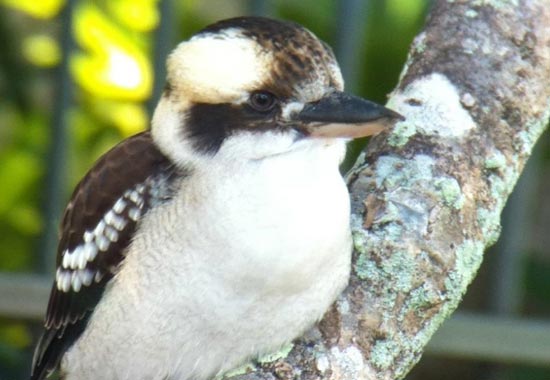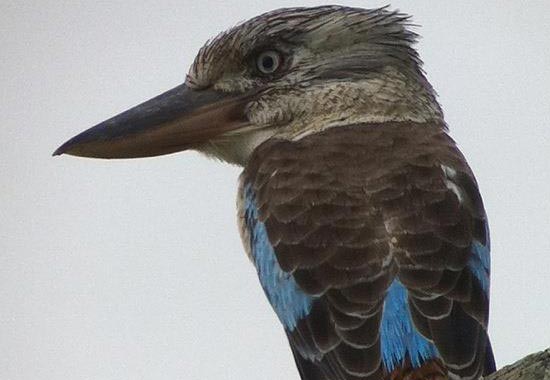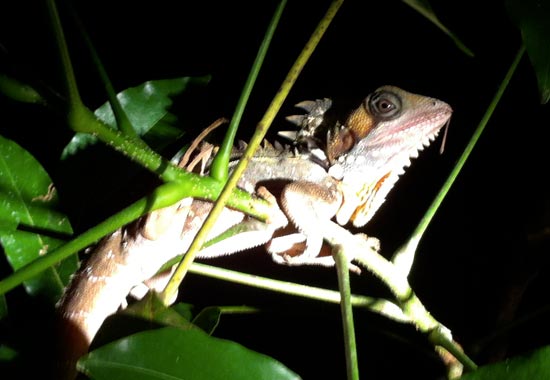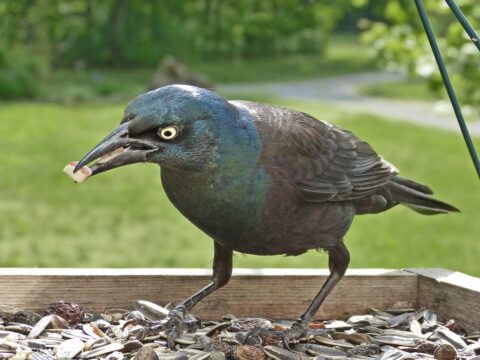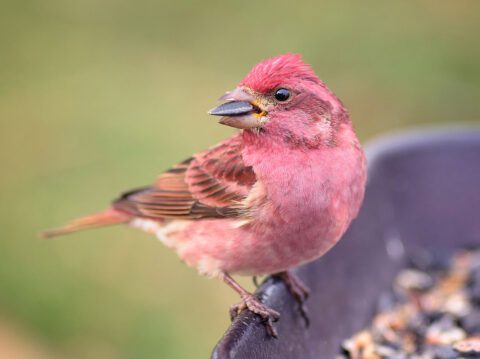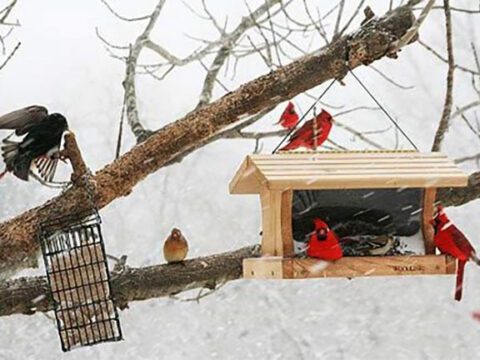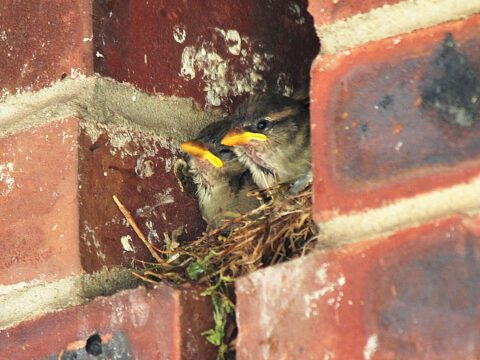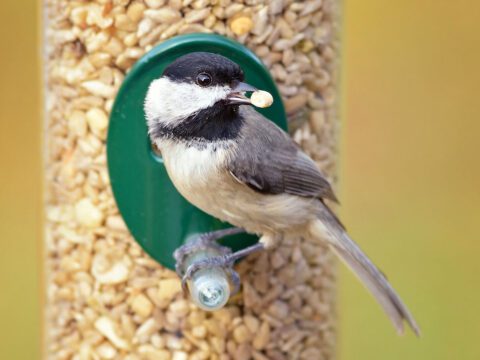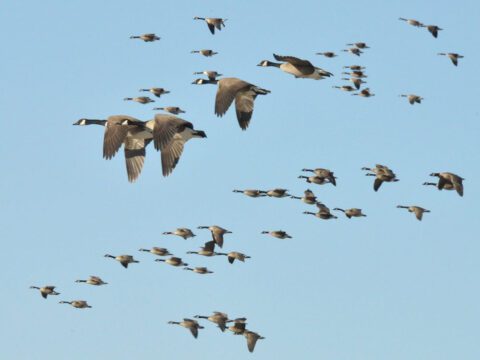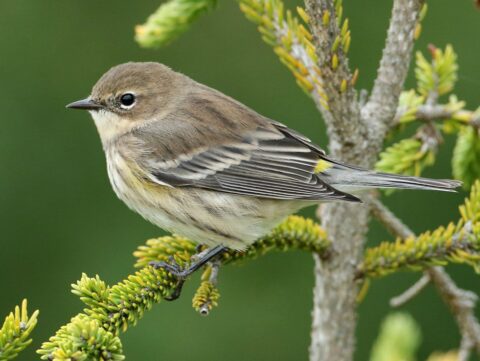A Tour of Australia’s Wet Tropics Endemics: Part Two [With Kookaburras!]
By Hugh Powell June 4, 2012
Laughing Kookaburras are bold birds with fantastical calls (listen below). 
The Blue-winged Kookaburra looks like a slightly insane Laughing Kookaburra. 
This Boyd's Forest Dragon is about the gentlest-looking dragon you'll ever see.
This is Part Two of a post about searching for the 12 endemic birds of northeast Queensland’s Wet Tropics World Heritage Reserve, with the help of many of the region’s wonderful guides and lodges. Part One of the story is here. Part Two introduces six endemic species not mentioned in Part One: Grey-headed Robin, Bridled Honeyeater, Bower’s Shrike-Thrush, Atherton Scrubwren, Mountain Thornbill, and Chowchilla.
If aliens were invading Earth and you had just half a day in which to see the 12 endemic birds of Australia’s Wet Tropics (see Part One), your best bet might be a drive up Mt. Lewis, just outside the hamlet of Julatten. Especially if the aliens were willing to let you take along Del Richards, of Fine Feather Tours, as a guide. A wiry 70-year-old with a quiet manner and an impressive roster of bird calls he can mimic, Del drove us up Mt. Lewis for a six-hour parade of rarities and endemics. Over just a few miles and a few thousand feet of elevation gain, we saw 8 of the 12 endemics that lure birders to this part of Queensland—and I got the distinct feeling Del was saving the others so we’d have something left for the second half of the week.
Del picked us up at Kingfisher Park Birdwatchers Lodge, a small lodge/caravan park run by two expat British birders, Keith and Lindsey Fisher. Kingfisher is itself a remarkable spot for both birds and strange Australian mammals. We didn’t see regional endemic birds here, but Keith showed us the way to a few unforgettable Australian specialties nonetheless, including kookaburras, a Channel-billed Cuckoo with a bill like a toucan’s, and a Buff-breasted Paradise-Kingfisher.
Kingfisher Park in the Dark
When night falls, Keith turns into something of a mammalogist—he leads nighttime prowls to look for bandicoots, gliders, quolls, and melomys, as well as frogs and owls. At the edge of a pasture we awakened a group of Laughing Kookaburras, which filled the air with their incredible, unhinged-sounding voices. For a few minutes it actually sounded like aliens were invading Earth. This is what we heard (recorded on my iPhone):
A bit later we rustled up some Blue-winged Kookaburras as well. Where Laughing Kookaburras can look cute and harmless, Blue-winged Kookaburras, with their enormous heads and staring yellow eyes, look like escapees from an asylum.
Down along the creek behind Kingfisher Park we walked around a sort of drowned orchard left over from previous owners. Marvelous fruits hung from twigs or collected in heaps underneath: starfruit, mango, longgon, rambutan, custard apple, and others. After the week’s heavy rains, the ground squelched under foot. Small, quick mosquitoes swarmed over our elbows and ankles. Noisy Pittas called from the depths of the forest, and later we glimpsed the flat tail of a feathertail glider hanging over the edge of a palm frond, as if he’d forgotten to pull it up out of view after landing. A couple of Spectacled Monarchs (looking like a cross between a Phainopepla and a Blackburnian Warbler) roosted on loops of vine about four feet over our heads, and we found them with our flashlight beams. At dinner, a forest dragon sat by the bird feeders in the light of the patio.
Parade on Mt Lewis
Del arrived in a cream-colored Land Cruiser, immaculately kept and sturdily built in the last century, with carpet lining the dashboard and stiff leather seats. He’s thin and silver-haired, an ex-cattleman who has been leading nature tours for 30 years. He wears a wide-brimmed leather hat—ubiquitous in Australia—with feathers in the hatband. Del climbed carefully aboard, remarking that he was just back to work after knee surgery (“my seventh knee if you count the two I started with”), and we wound around the narrow roads. We passed Julatten’s football field, tennis court, and public library in one go, and turned onto the narrow strip of asphalt that leads to Mt. Lewis.
I was struck everywhere I went by how familiar the tropical vegetation looked and how unfamiliar the birds were. I’m sure the plant species were as unique as any of the birds, but to the casual observer the dense walls of dark green that climbed the hillsides, the tree ferns that spread out like table umbrellas, and the thorn-encumbered palm fronds looked familiar from my visits to Panama and Costa Rica. And just as in Central America, we entered the forest only gradually: first cruising through cattle pastures, and then into the broken shade of the first scraggly trees bending over the road. The asphalt disappeared and Del began negotiating the Land Cruiser around chuckholes and over washboards. Clouds descended, and the vegetation became thicker and wetter.
We were using one of the standard ploys of bird watchers the world over: drive a dirt road up a mountain, and watch the birds change as you climb through elevations and habitats. Every time we stopped the car we heard unusual sounds—the sharp descending notes of Yellow-spotted Honeyeaters; the thin trills of a Chestnut-breasted Cuckoo. Each time, Del’s fingers hovered over the ignition key as he gauged whether to stop against his goal of reaching the grassy end of the road, where Blue-faced Parrot-Finches cling to seedheads and Australian King-Parrots wing over.
Foraging flocks of 20 birds or more made their stately way over the road through the twigs, vine tangles, and crumpled brown leaves. In one of these, a parade of little warbler- and vireo-like birds turned into something of an endemic explosion: As Fairy Gerygones chattered in the canopy, a Mountain Thornbill worked its way down slender vines and a couple of Atherton Scrubwrens came up from the midstory to meet it. Suddenly a longer bird with a heavier bill hopped in to have a look around: a Bower’s Shrike-Thrush making its way methodically through, a bit like a Summer Tanager might move (my colleague Mike Weedon got some good photos). Below them, along the road-edges, Grey-headed Robins were both common and showy. These rich-brown, short-tailed birds swooped from ground to low perch and then stood at attention (not unlike an American Robin’s alert posture, although the two species are not the least bit closely related).
One of my favorite activities in Australia was working through the honeyeater family and its 70+ species. Around Mt. Lewis and Kingfisher Park I puzzled over Graceful, Yellow-spotted, Lewin’s, and Bridled honeyeaters. All of these are smoothly colored olive-green birds, each with a prominent dot, crescent, or teardrop on the side of the face. Yellow-spotted were perhaps the most common; Graceful were a bit daintier (see photo here), but hard to distinguish alone; Lewin’s was larger and darker on the head. And now, at the top of Mt. Lewis, Bridled Honeyeater, the one with the stormiest coloring, and the least yellow, made an appearance high in the treetops.
At the top of Mt Lewis, Del showed us one of the gaudiest finches I’ve ever seen, the Blue-faced Parrot-Finch, and then gestured down a dirt track at a Golden Bowerbird territory he knew about. But it was getting late—shadows were already making it hard to see under the canopy—and anyway Del wanted his guiding friends David “Chook” Crawford and Alan Gillanders to have their chance to show us some new species, too.
As we jounced back down the mountain, a couple of dark birds scampered off the side of the road and Del whispered “Chowchillas!”—our last regional endemic for the day. We crept to the edge of the road and looked what seemed like straight down a steep, leafy slope. Chowchillas are long-legged, sociable birds that haunt the understory. They are smartly colored in rich dark brown with white (male) or buffy (female) underparts. In the gloomy understory they were almost invisible, but my binoculars gathered just enough light to make out the bold, staring eyering and their gingerish way of stepping through the leaves. After my eyes adjusted, I could see 6 or 8 of them scattered down the slope. These large groups spend so much time together that their songs are a group effort, with some of the birds shouting “Chow” and others “Chilla” in a tight, circular rhythm [listen].
As we got in the Land Cruiser to head back down, I half-wondered if it was the sound of aliens invading. But then I remembered, of course—all these outlandish creatures live here, and I’m the alien.
(Photos iphoniscoped by Hugh Powell. The Laughing Kookaburra pic was taken at Villa Marine, a delightful accommodation in the town of Yorkeys Knob adjacent to Cairns.)

All About Birds
is a free resource
Available for everyone,
funded by donors like you
American Kestrel by Blair Dudeck / Macaulay Library
